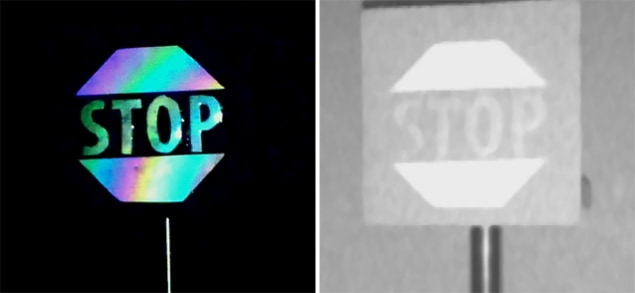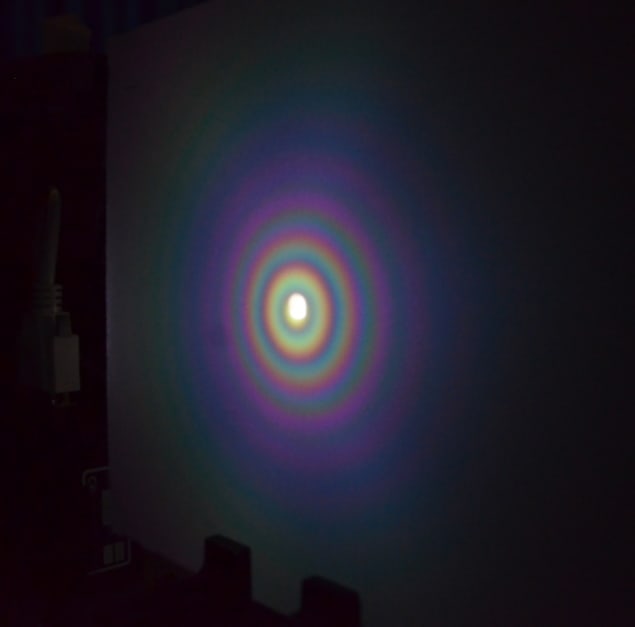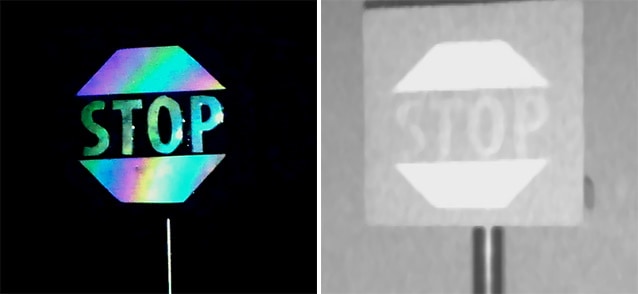
A structural colour technology that produces concentric rainbows could help autonomous vehicles read road signs, scientists in the US and China claim. As well as exploring the physics of these novel reflective surfaces, the researchers show that they can produce two different image signals at the same time. Autopilot systems that read both signals would be less likely to misinterpret altered road signs, they suggest.
Car autopilot systems use infrared laser-based light detection and ranging (lidar) systems to scan their environment and recognize traffic situations. But these systems cannot recognise traffic signs. To read signs, autonomous vehicles rely on visible cameras and pattern recognition algorithms.
In recent years, researchers have demonstrated that these visual systems can be fooled by physically hacked or damaged road signs. Placing stickers on stop and speed limit signs resulted in some autopilot systems misidentifying them as faster speed limit signs. This could cause cars to accelerate when they should be slowing down.
“The challenge for those artificial intelligent systems is that the signal for them to identify the traffic sign is limited in a conventional traffic sign,” explains optical engineer Qiaoqiang Gan, from the University at Buffalo. “They only rely on the visible pattern.”

Gan and his colleagues think they may have a solution. In 2019 they described a new reflective film that consists of a single layer of polymer microspheres on the sticky side of a transparent tape. These structures are known as microscale concave interfaces. When white light is shone on the film it produces multiple concentric rainbows.
“This phenomenon is very interesting and to our knowledge we cannot observe this type of multi rainbow from naturally existing materials,” Gan tells Physics World.
The researchers initially thought that this material could be used to produce hyper-reflective road signs. These could be great at night as they would not need their own light source, cutting energy consumption and light pollution. The colour of the reflection also changes when observed from different distances and angles. The team showed how this could be leveraged to create passive but smart road signs.
For example, if someone was walking along a dark road towards a road sign and a fast-moving car with its headlights on approached from behind them the sign would change colour. This is because the distance and angle between the headlights and the sign changes relative to the pedestrian. For the driver, however, the colour of the sign stays the same, as their position relative to the headlights is fixed. “This is an interesting optical phenomena to two different observers,” Gan says. “One person will see a stable traffic sign; another will see colour changing. In a dark environment this might be helpful to alert this slowly moving pedestrian to pay attention.”
Alternatively, if the sign has its own light source, it appears to change colour to an approaching driver. This could be useful to alert them to particularly important signs.
Improved sign recognition
In their latest work, published in Applied Materials Today, Gan and his colleagues demonstrate how their earlier findings could be exploited to produce different visual and infrared signals. In a series of experiments, they illuminated signs containing microscale concave interfaces with a fixed light source and scanned them with a moving visual camera and a lidar system. Echoing their earlier work, the visual system saw a colour-changing sign, as it shifted position relative to the light source. But as the lidar system moved with the infrared laser, it saw a stable infrared image.
The researchers believe that if autopilot systems could use lidar to map these signs, the simultaneous visible colour change and stable infrared image could significantly improve pattern recognition. Autonomous vehicles could then be less likely to misclassify damaged or altered road signs.

Raining on the parade of self-driving cars
The researchers also probed the physics of the microscale concave interfaces. They found that depending on the angle at which the light enters the spheres, it is reflected internally two or three times before exiting. This means that even a single light source produces beams of light that exit the spheres at a multitude of angles. These then interfere with each other creating the multiple rainbow ring pattern.
Gan tells Physics World that the team is now looking for collaborators to develop and test robotic systems to read the signs.
